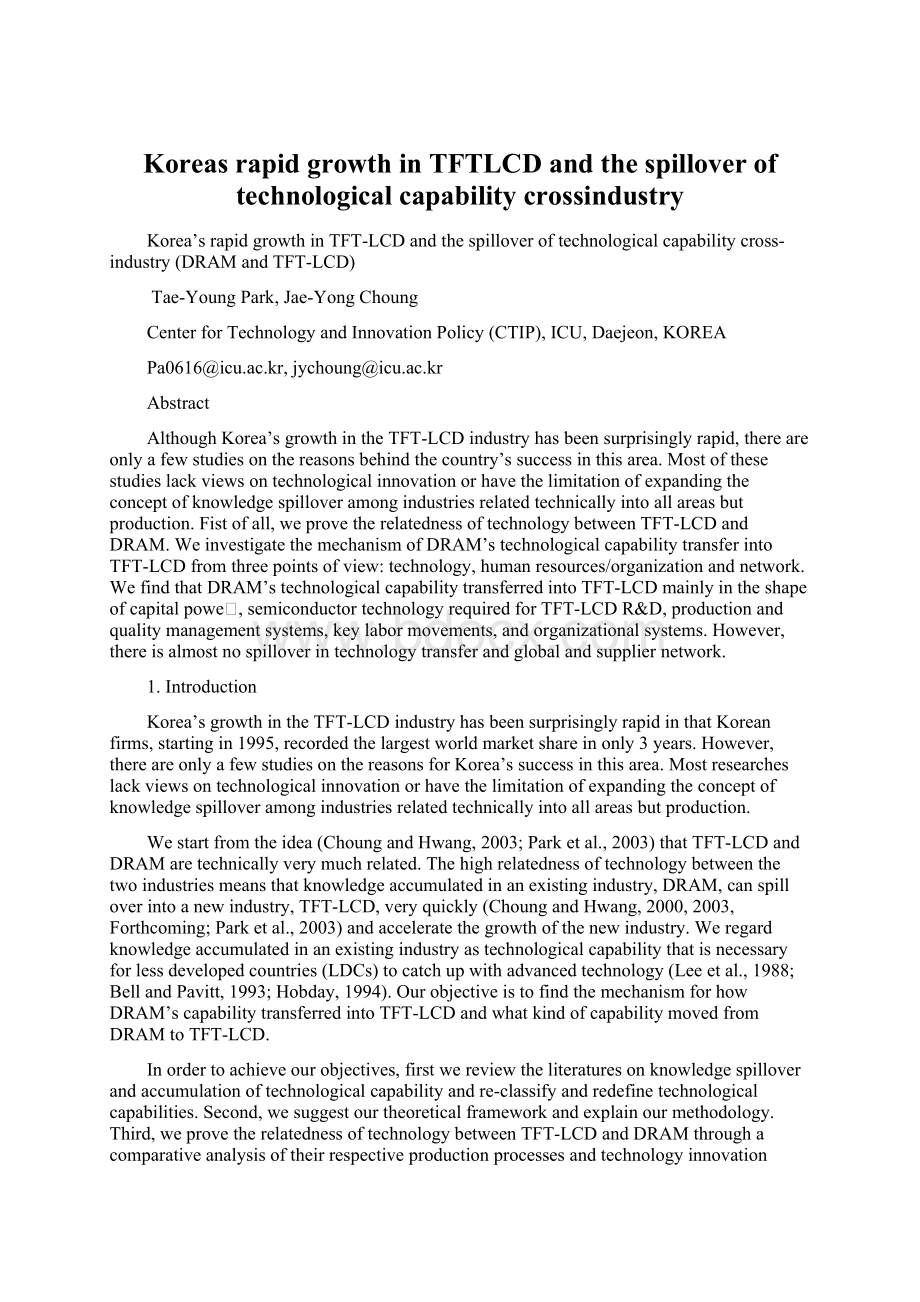Koreas rapid growth in TFTLCD and the spillover of technological capability crossindustry.docx
《Koreas rapid growth in TFTLCD and the spillover of technological capability crossindustry.docx》由会员分享,可在线阅读,更多相关《Koreas rapid growth in TFTLCD and the spillover of technological capability crossindustry.docx(10页珍藏版)》请在冰豆网上搜索。

KoreasrapidgrowthinTFTLCDandthespilloveroftechnologicalcapabilitycrossindustry
Korea’srapidgrowthinTFT-LCDandthespilloveroftechnologicalcapabilitycross-industry(DRAMandTFT-LCD)
Tae-YoungPark,Jae-YongChoung
CenterforTechnologyandInnovationPolicy(CTIP),ICU,Daejeon,KOREA
Pa0616@icu.ac.kr,jychoung@icu.ac.kr
Abstract
AlthoughKorea’sgrowthintheTFT-LCDindustryhasbeensurprisinglyrapid,thereareonlyafewstudiesonthereasonsbehindthecountry’ssuccessinthisarea.Mostofthesestudieslackviewsontechnologicalinnovationorhavethelimitationofexpandingtheconceptofknowledgespilloveramongindustriesrelatedtechnicallyintoallareasbutproduction.Fistofall,weprovetherelatednessoftechnologybetweenTFT-LCDandDRAM.WeinvestigatethemechanismofDRAM’stechnologicalcapabilitytransferintoTFT-LCDfromthreepointsofview:
technology,humanresources/organizationandnetwork.WefindthatDRAM’stechnologicalcapabilitytransferredintoTFT-LCDmainlyintheshapeofcapitalpowe,semiconductortechnologyrequiredforTFT-LCDR&D,productionandqualitymanagementsystems,keylabormovements,andorganizationalsystems.However,thereisalmostnospilloverintechnologytransferandglobalandsuppliernetwork.
1.Introduction
Korea’sgrowthintheTFT-LCDindustryhasbeensurprisinglyrapidinthatKoreanfirms,startingin1995,recordedthelargestworldmarketshareinonly3years.However,thereareonlyafewstudiesonthereasonsforKorea’ssuccessinthisarea.Mostresearcheslackviewsontechnologicalinnovationorhavethelimitationofexpandingtheconceptofknowledgespilloveramongindustriesrelatedtechnicallyintoallareasbutproduction.
Westartfromtheidea(ChoungandHwang,2003;Parketal.,2003)thatTFT-LCDandDRAMaretechnicallyverymuchrelated.Thehighrelatednessoftechnologybetweenthetwoindustriesmeansthatknowledgeaccumulatedinanexistingindustry,DRAM,canspilloverintoanewindustry,TFT-LCD,veryquickly(ChoungandHwang,2000,2003,Forthcoming;Parketal.,2003)andacceleratethegrowthofthenewindustry.Weregardknowledgeaccumulatedinanexistingindustryastechnologicalcapabilitythatisnecessaryforlessdevelopedcountries(LDCs)tocatchupwithadvancedtechnology(Leeetal.,1988;BellandPavitt,1993;Hobday,1994).OurobjectiveistofindthemechanismforhowDRAM’scapabilitytransferredintoTFT-LCDandwhatkindofcapabilitymovedfromDRAMtoTFT-LCD.
Inordertoachieveourobjectives,firstwereviewtheliteraturesonknowledgespilloverandaccumulationoftechnologicalcapabilityandre-classifyandredefinetechnologicalcapabilities.Second,wesuggestourtheoreticalframeworkandexplainourmethodology.Third,weprovetherelatednessoftechnologybetweenTFT-LCDandDRAMthroughacomparativeanalysisoftheirrespectiveproductionprocessesandtechnologyinnovationsystems.Fourth,weshowtheresultsofacasestudyweconductedwithSamsungandLG.Andfinally,wepresentourpaper’simplicationsandlimitations.
2.LiteratureReview
LiteraturesonKorea’sTFT-LCDsuccessaresummarizedasfollows.
Atthefirmlevel:
Koreanfirms’successcanbeattributedtohighproductiontechnologyandtheindependenceoftechnology(Chang,2005),uniquepropensitiesfavoringlargescaleinvestmentandafirstmoverstrategy(Hung,forthcoming),highverticalintegrationinequipmentandparts/materialfirms,andstrategicallianceswiththeUnitedStates,Japan,ChinaandASEAN(Linden,Hart,Lenway,1998).
Attheindustrylevel:
ThecharacteristicindustrialstructureinTFT-LCDisacrystalcyclewhichoffersopportunityofsuccessfulentrytonewfirmswhenthecycleisfacingadownturn(Mathews,2005).
Atthenationallevel:
StrongsupportoftheKoreangovernmentsuchasdirectfinancing(Linden,Hart,andLenway,1998).
Atthetechnologylevel:
TechnologyrelatednesssuchasproductionprocesstechnologybetweenTFT-LCDandDRAM(ChoungandHwang,2003;Park,etal.,2003).
However,thepreviousstudieshaveafewlimitations.First,studiesatthefirmlevelarelikelytobeinterpretedpostfactumandcannotexplainthemechanismofsuccess.Second,thecrystalcyclecannotshowwhythesuccessfulfirmsarespecificallyKoreanfirms.Third,inTFT-LCD,theKoreangovernmentdidnotplayamajorrole,unlikeDRAMandCDMA.
2.1KnowledgeSpillover
Knowledgespilloveristhenon-appropriableamountofknowledgethatisproducedbyafirm’sinnovationefforts(Griliches,1992).Knowledgespilloverhaspositiveexternalityinthatitpreventsinnovationactorsfromcompletelyappropriatingtheirknowledge,therebyallowingevennon-innovationactorstobenefitfromit.Thisdeniesthecompletecompetitionassumptionofclassicaleconomics,acceptsmarketfailureandofferstheexcuseofgovernmentinterruptiontothemarket.Therefore,ifacertainindustryhasknowledgespilloverthatleadstoalotofpositiveexternalities,thegovernmenttriestostrategicallysupportandfosterthatindustry.Theseindustriesarecalled“technologydrivers,”ofwhichthemostrepresentativeexampleisDRAM(Malerba,1985;BaldwinandKrugman,1988;Dick,1991;Gruber,1992;Flamm,1993a;IrwinandKlenow,1994a;UdayagiriandSchuler,1999).
Themoreindustriestechnicallyrelatetoeachother,themoreknowledgespilloverhappens(UdayagiriandSchuler,1999;MalerbaandMontobbio,2003).TheconceptsbasedonDRAM’sroleasa“technologydriver”andthetechnologicaldistanceofknowledgespilloversupportthepossibilityofaknowledgetransferfromDRAMtoTFT-LCD.
Weregardknowledgeastechnologicalcapability—everythinggeneratingandmanagingatechnicalchange(BellandPavitt,1993).
2.2AccumulationofTechnologicalCapabilities
Technologicalcapabilityreferstotheabilitytomakeeffectiveuseoftechnologicalknowledgeineffortstoimitateandassimilateexistingtechnologies,createnewones,anddevelopnewproductsandprocessesinresponsetothechangingeconomicenvironment(Kim,1997a).
ManyliteraturesmentiontheimportanceofthoseintheLDCsaccumulatingtechnologicalcapabilitiesinternallyinordertocatchupwithadvancedtechnology(Leeetal.,1988;BellandPavitt,1993;Hobday,1994).
Therehavebeenmanyeffortstomeasurethistechnologicalcapabilityinpreviousstudiesbothatthemacroandmicrolevel.Atthemacrolevel,therehavebeenfivedifferentattemptstomeasuretechnologicalcapabilities:
theWEFTechnologyIndex(WEF,2001,2002,2003;Furmanetal.,2002);theUNDPTechnologyAchievementIndex(UNDP,2001;Desaietal.,2002);theArCOIndicatorsofTechnologicalCapability(ArchibugiandCoco,2004);theRANDIndustrialDevelopmentScoreboard(UNIDO,2002;LallandAlbaladejo,2001);andtheScienceandTechnologyCapacityIndex(Wagneretal.,2004)2.Atthemicrolevel,themostcommononescanbeplacedintooneofthreedifferentcategories:
R&Dexpenditures,patentstatistics,andstatisticsonnewproductintroductions.Firmtechnologicalcapabilities(FTC)canbedividedintoscaleFTCandqualityFTC(SchoeneckerandSwanson,2002).Technologicalcapability(TC)alsocanbedistinguishedfromtechnologicalefforts,inputsforTC,andfromeconomicperformances,theeffectsofTC(Jonkeretal.,2006).Theabovetwoapproachesdonotconsiderthelevelofeconomicdevelopmentofacountry.However,thereareseveralstudiesthatconsiderthefactthatpatternsoftechnologydevelopmentdiffersignificantlybetweenLDCsandDCs(MohanBabuandGanesh,1997;Kim,1999;Yuetal.,2004;ChoandLee,2003)3.
Wesuggestanewclassificationoftechnologicalcapabilitiesthroughreviewingpreviousstudies.Thenewclassificationiscomprisedofthreecategories:
technology,humanresourcesandorganizationnetwork,asshowninTable1.
3.TheoreticalFrameworkandMethodology
OurframeworkisforprovingthepossibilitythatDRAMknowledgecanspilloverintoTFT-LCD,basedonthesimilarityoftheirproductionprocessesandtechnologyinnovationsystems.Itisalsoforfindingthemechanismforknowledgespilloverintermsoftechnology,humanresources/organizationandnetwork(Figure1).
WecollectedfirmdatafrominterviewswithmanagersofSamsungElectronicsandLGPhilipsLCD,aswellasfrombusinessreportsofferedbyDART4andannualreportssuppliedbyhomepages.Forconsultingontechnologyandpatents,weinterviewedresearchersofseveralresearchinstitutes5.WealsousedAurekaDBof9.0versionforpatentanalysis.
4.TechnologyRelatednessbetweenDRAMandTFT-LCD
4.1.SimilarityofProductionProcessTechnology
InTFT-LCDproductionprocesses,theTFTarrayandcolorfilterprocessesincludearepeatedpatterningprocess:
decomposition,cleaning,PRcoating,exposure,developing,etching,andinspection.ThispatterningprocessisverysimilartothefabricationprocessofDRAM(Figure2).
4.2SimilarityofTechnologyInnovationSystem
Therelatednessoftechnologybetweenthetwoindustriesmakesthecharacteristicsofinnovators,themajorsourcesofinnovation,thekeycapabilitiesofinnovation,andthechangesofenvironmentandtechnology,similar.Thisisconsistentwiththeconceptthatindustriesinthesamesectoroftenhaveasimilarpatternoftechnologyinnovation(Pavitt,1984).
AsshowninTable2,almostallthecharacteristicsofthetechnologyinnovationsystems
ofthetwoindustriesaresimilarexceptthatTFT-LCDisconsideredcustomizedgoods,whileDRAMisconsideredcommoditygoods.
5.CaseStudy
TheperiodforcasestudyisrestrictedtothetimeSamsungandLGbeganR&D(mid1980s)towhenthetwocompaniesacquiredsuccessintheworldmarket(late1990s).
5.